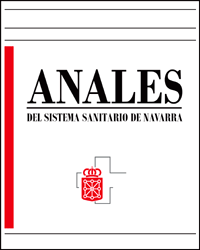Pheochromocytoma and paraganglioma
DOI:
https://doi.org/10.23938/ASSN.0650Keywords:
Feocromocitoma. Paraganglioma. Catecolaminas. HTA. Crisis hipertensivas.Abstract
Pheochromocytoma and paraganglioma are neoplasias of the chromaffin cells that manifest themselves in some 40-60% of cases by symptoms of episodic freeing of catecholamines. They are the cause of stable and malign HTA in some 0.1-1% of cases and must be discounted in a study of the same. They most frequently affect males and their incidence increases with age. The symptomatic episodes are basically characterised by high blood pressure, migraines, sweating and palpitations, although they can have other multiple manifestations and even take a silent form in upto 40-50% of cases. They are frequently associated (10%) with multiple endocrine neoplasias and other neuroectodermic syndromes. For their diagnosis it is essential to measure the catecholamines and their metabolites, both plasmatic and urinary, and to locate the tumour by means of image tests, especially magnetic resonance. In the handling of these tumours it must be born in mind that the carrying out of physical maneuvers on the tumour and the employment of drugs that free catecholamines can induce hypertensive crises. The treatment chosen is always surgical, curative in cases of benign pheochromocytoma or producing a reduction of the tumourous mass and associated symptoms in cases of malign pheochromocytoma (10%); in this latter case treatment is complemented with chemotherapy or drugs that control the tumourous symptoms. Untreated pheochromocytoma can be a mortal disease, hence the importance of its detection and early treatment.Downloads
Downloads
Published
How to Cite
Issue
Section
License
La revista Anales del Sistema Sanitario de Navarra es publicada por el Departamento de Salud del Gobierno de Navarra (España), quien conserva los derechos patrimoniales (copyright ) sobre el artículo publicado y favorece y permite la difusión del mismo bajo licencia Creative Commons Reconocimiento-CompartirIgual 4.0 Internacional (CC BY-SA 4.0). Esta licencia permite copiar, usar, difundir, transmitir y exponer públicamente el artículo, siempre que siempre que se cite la autoría y la publicación inicial en Anales del Sistema Sanitario de Navarra, y se distinga la existencia de esta licencia de uso.








